
The mountain lion is one of five native cats under threat in Texas. Photos courtesy of Texas Native Cats.
May 2, 2018
A Dallas woman wants to raise awareness about Texas' native cats – not the domestic felines we know and love as pets but the wild kind, native to to the Lone Star State. There are five: the big cats - jaguar and mountain lion - (also called cougars or pumas), and the smaller cats - bobcat, ocelot and jaguarundi.
 “The main reason I formed Texas Native Cats is all of them for various reasons are under threat. And the source of that threat can be summed up in one word: people,” says Dallas resident Monica Morrison. “Whether it’s loss of habitat, fragmentation of habitat, trapping, traffic, we caused it.”
“The main reason I formed Texas Native Cats is all of them for various reasons are under threat. And the source of that threat can be summed up in one word: people,” says Dallas resident Monica Morrison. “Whether it’s loss of habitat, fragmentation of habitat, trapping, traffic, we caused it.”
A few shocking facts, good and bad:
• The jaguar, ocelot and jaguarundi are listed as endangered in the United States.
• Bobcats, as well as pumas (also called mountain lions and cougars), may be hunted at any time if local regulations allow.
• Texas is the only state with a puma population in the U.S. that does not have some form of protection for them.
• Jaguars are a member of the genus Panthera that includes lions, tigers and leopards.
• The genus of pumas, jaguarundis and cheetahs is Felidae, shared by domestic cats.
• Texas is one of the biggest per capita offenders in private exotic cat ownership.
• The bobcat is the most widely harvested feline species for its fur, mainly to overseas markets.
• Ranging from the tip of South America into Canada, pumas are the most widely spread, albeit often sparsely populated, terrestrial mammal in this hemisphere besides humans.
• Jaguarundis have not been officially seen in Texas since the 1980s.
• The last jaguar seen in Texas was in the 1930s.
 Monica Morrison, founder of Texas Native Cats.
Monica Morrison, founder of Texas Native Cats.
Texas Native Cats, a Dallas-based nonprofit, makes educational presentations to garner support for these beautiful but threatened Texas felines. Morrison has over 15 years working with exotic cats, in the wild and in captivity at International Exotic Animal Sanctuary in Boyd, InSync Exotics in Wylie, and Dallas Zoo. She has participated in exotic cat research expeditions Mexico and Kenya, jaguar projects in Arizona and Brazil, and numerous mountain lion workshops and big cat conferences.
“I decided to look in my own backyard – a pretty big backyard when you consider the size of the state – and educate people about these predators, what they do and how we need to react to them and why we need to learn to coexist,” says Morrison.
HUMANS VS PREDATORS
“The only good puma is a dead puma.”
It’s a sentiment heard all over the rural west. It’s even more widespread if you replace puma with another carnivore like bobcat, or even omnivore such as bear, wolf, coyote or fox.
“From the time European settlers came here, they wanted to eliminate all predators and did a pretty good job of it,” says Morrison.
Yet the threat pumas pose to humans and livestock is minimal, and for bobcats and omnivores it’s non-existent.
Why the fear and animosity? The answer, says Morrison, can be found in a quote by Chief Dan George: “What you do not know you will fear, and what one fears one destroys.” Or as writer Andrew Smith expounds: “People fear what they don't understand and hate what they can't conquer.” While big cats may be held captive, they are rarely conquered.
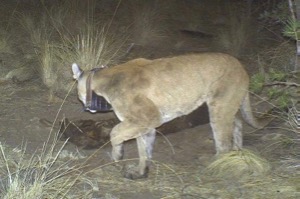 Humans simultaneously exalt big cats – sports teams and cars share their monikers, their names serve as metaphors for male virility and business success – while fearing and destroying them.
Humans simultaneously exalt big cats – sports teams and cars share their monikers, their names serve as metaphors for male virility and business success – while fearing and destroying them.
The Borderlands Research Institute at Sul Ross State University has investigated 200 kill sites of mountain lions and found no livestock remains. This mountain lion has returned to a feral hog it killed 3 days earlier. Courtesy of Sul Ross State University.
“There’s a tremendous amount of ignorance about the role of predators and how much they really do in terms of killing livestock,” says Morrison.
The only research on Texas pumas comes out of Sul Ross State University in Alpine. In an ongoing Davis Mountains study, in the 200 kill sites examined so far there was no livestock remains.
“Livestock is not their preferred prey,” says Morrison. “They’re killing deer and javelinas. They’re taking down feral hogs.”
“There’s evidence, though not totally proven at this point, continues Morrison, “that mountain lions will target deer with chronic wasting disease, for which there is no cure, and they don’t contract the disease. So they’re doing everybody a favor.”
But a daffy human, ambling alone down a remote path without being aware of their surroundings (something they’d know better what to do in the city), is an easy target for an adult puma or cougar. So some fear is real.
“We have told ourselves, which I question a lot, that we are the superior species,” says Morrison. “Top of the food chain. And then we find out we’re not. It’s unsettling.”
PREDATORS' ROLE
Referred to as keystone or flagship species, predators are top-down regulators of wildlife populations, especially herbivores, which out of control will decimate plant populations. By removing habitat cover as well as food, a habitat’s ecosystem is sent into a tailspin.
While populations used to be kept in check by hunting and sport shooting, Americans’ bloodlust for animal death is at an all-time low. As a result, herbivore populations are escalating, leading to starvation and disease.
“Predators maintain the balance in nature,” says Morrison. “They’re the top of the food chain. If there are predators present, it’s the sign of a healthy ecosystem.
Watch 'The Lions of West Texas,' a seven-minute film on pumas for National Geographic by Ben Masters.
For those reasons, pumas are starting to retake their U.S. territory that once stretched to the east coast, moving from the Rocky Mountains and west into places like Missouri and Iowa. Western Nebraska and South Dakota now have resident populations, mostly young males, but recently a female made it all the way to Tennessee.
“It’s been going on for a few years now,” says Morrison. “So far it’s been what they call sub-adult dispersing males. Like a teenager, mom boots him out: ‘Go find your life, kid.’ So they’re forced out to find their own territory. Typically, male mountain lions require a much larger territory than the female.”
Ranchers west of Fort Worth have seen them for years, usually far off in riparian corridors. Earlier this year, a driver killed a puma outside Weatherford.
“Mountain lions are starting to colonize their former habitat,” says Morrison. “It will be interesting to see how far they go and the reactions of people in these states that haven't seen a predator like that in 100+ years.
TEXAS CATS AT A GLANCE
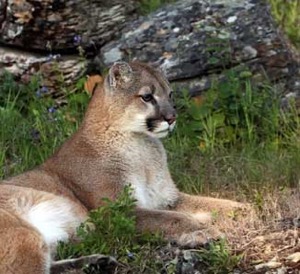 Mountain Lions
Mountain Lions
Puma concolor
• Weight: Males: 110-232 pounds. Females: 79-132 pounds
• Texas territory: West Texas and South Texas, though sighted elsewhere
• Habitat range: Males: 75-150 square miles. Females: 24-50 square miles
• Notes: Also known as cougars, pumas and occasionally panthers.
• Neat fact: Pumas can leap 30 feet and spring 15 feet vertically.
Pumas are noted for their solid tawny color. They are incredibly adaptable but very elusive and reluctant to be seen. They prefer deer, elk, moose and other herbivores, plus smaller animals such as coyotes, foxes and raccoons. Rabbits, squirrels and rats are a pleasant snack.
The proliferation of game cameras has brought insight into the mysterious nocturnal cat, mainly that they are far more social than prior believed. Unrelated males share kills and travel together, females with kittens take in orphans.
The most stable population of pumas is in the Davis Mountains, which boasts plentiful game and stable contiguous habitat. Yet trapping is the primary cause of mortality in West Texas. The South Texas population is very fragmented with few travel corridors.
But you won’t find a puma in urban Dallas and other North Texas cities that lack thick uninterrupted riparian corridors essential for travel; see habitat range, above. Pumas are large and consume a prodigious amount of food. Their preferred prey is in the 50-pound and up range. Scat and kill remains would be visible. Night workers would have seen them. Brett Johnson, urban biologist for city of Dallas, says he has checked out over 100 calls of suspected puma prints and none panned out. Chris Jackson of DFW Urban Wildlife has a superior tutorial on interpreting a potential puma sighting.
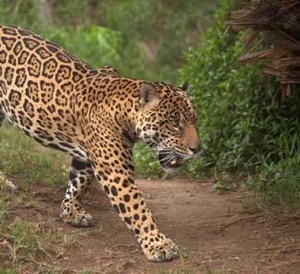 Jaguars
Jaguars
Panthera onca
• Weight: 80-300 pounds.
• Texas territory: not detectable
• Neat fact: Jaguars have a black melanistic form that occurs in 6 percent of the population, though although spots are visible in bright light. It occurs higher than a normal mutation rate, indicating it is a result of selection.
The stocky, compact jaguars are the third biggest cat in the world, behind lions and tigers. Their large black spots on a tawny background are denser on the head and neck, with rosette-shaped patterns on the torso. Their massive jaws are powerful enough to crush skulls. As excellent swimmers, they can prey on large fish, reptiles, turtles and water mammals, yet they are also superb climbers able to prey on arboreal creatures and birds. Herbivores are a primary prey. They prefer densely foliated habitat but are known to inhabit high mountains and swamps.
Revered by Mayan and all indigenous people in southern Mexico, Central and South America, they are considered highly intelligent cats that tend to do poorly in captivity. (The jaguar at the Dallas World Aquarium radiates misery.) Morrison shares a vignette from her time at International Exotic Animal Sanctuary to illustrate the jaguar composure and intelligence:
“Domino was not a large jaguar, nor friendly, but the smartest and most cunning. In hot weather, we placed blocks of ice into the big cats’ enclosures. One August, I saw him eye the ice block, pick it up with his paws – it weighed over 20 pounds – and steady it with his chin as he put it where he wanted it. I watched him roll the ice block to the edge of his pool. He picked it up with paws, again steadying it with his chin, and plopped it in the water. “
“Do animals have intelligence? Can they reason through problems? Yes, they can. He knew exactly how to get from point A to point B with that ice block. He was my favorite cat.”
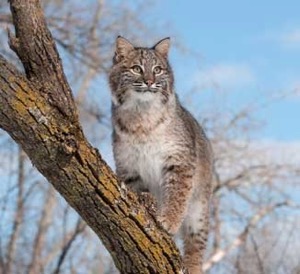 Bobcats
Bobcats
Lynx rufus
• Weight: Males: 24-28 pounds. Females: 18-22 pounds
• Texas territory: state wide
• Habitat range: Males: 25–30 square miles. Females: 5 square miles
• Notes: Bobcats can make a loud, blood-curdling scream.
• Neat fact: The estimated Texas population is 287,000 to 1.3 million.
Named for their short tails, they are noted for peaks of long fur at their jowls and tufts on the ears. They are abundant in Texas with one subspecies, Lynx rufus texensis, and prefer rocky terrain, though are highly adaptable and can live in swamps, deserts, and urban areas.
Among urban wildlife, coyote holds down the day shift while bobcats operate at night. City dwellers have been co-existing with bobcats for decades. For details, visit the DFW Carnivores project at iNaturalist.
The bobcat is the most widely harvested feline species for its fur. It takes 40 bobcat pelts to make a coat. The denser, softer fur of mountain bobcats is preferred. Most slaughtered bobcat pelts are shipped to China or Russia.
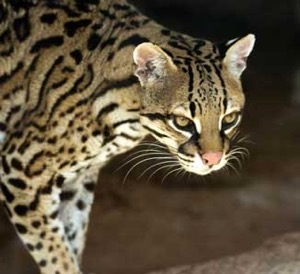 Ocelots
Ocelots
Leopardus pardalis
• Weight: Males: 20-30 pounds. Females: 15-20 pounds
• Texas territory: Laguna Acosta National Wildlife Refuge
• Habitat range: 1-4 square miles
• Notes: Far more numerous in Central and South America.
• Neat fact: Ocelot markings are unique; no two cats have the same pattern.
The ocelot, a spotted and striped cat, preys on small animals such as rodents, rabbits, birds and snakes. Once found in much of Texas, Louisiana, Arkansas and Arizona, the only remaining U.S. population, around 80, is in far South Texas. Morrison credits resurgence from 30 cats to ranchers around Laguna Acosta setting aside scrub thorn habitat. The U.S. Fish and Wildlife Service recovery plan aims to encourage a level of 275 ocelots to enable removal from the endangered species list.
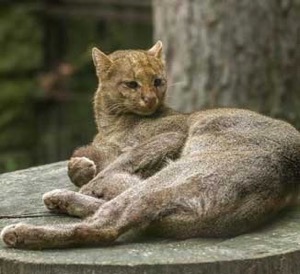 Jaguarundi
Jaguarundi
Puma yagouaroundi
• Weight: 7 to 20 pounds
• Texas territory: not detectable
• Notes: Far more numerous in Central and South America.
• Neat fact: Jaguarundis are diurnal, or active during the day.
Long and thin with short legs and pointed face, the jaguarundi has a weasel-like appearance. The solid color coat ranges from black to brown-grey (grey phase) or orangish red to ruddy (red phase).
WILD CAT RESOURCES
Borderlands Research Institute at Sul Ross State University. Understanding and conserving the natural resources and wildlife of the Chihuahuan Desert Borderlands.
Panthera. The only organization in the world that is devoted exclusively to the conservation of the world's 40 wild cat species and their landscapes.
Texas Native Cats. Dedicated to the wild cats native to Texas.
Wild Felid Association. Focused on pumas, but broadening their areas of interest to include smaller cats.
See Native Texas Cats in North Texas
Center for Animal Research and Education, Bridgeport
InSync Exotics, Wylie
International Exotic Animal Sanctuary, Boyd
Stay up to date on everything green in North Texas, including the latest news and events! Sign up for the weekly Green Source DFW Newsletter! Follow us on Facebook and Twitter.









